Eisele Vineyard is one of the oldest single vineyard estate bottlings in the Napa Valley. Based near Calistoga on hillside plots, the soils for the top bottlings are based on an alluvial fan. After early plantings of Zinfandel and Riesling, Cabernet Sauvignon was planted here in the early 1960s. The first bottling of these Cabernet plantings that bore the name Eisele Vineyard came in 1971 when a young Paul Draper (of Ridge fame) made the wine. While now impossibly rare to find, these legendary bottles are apparently still youthful, fresh and balanced, a testament to the terroir here. Subsequently plantings of Sauvignon Blanc, Syrah, Cabernet Franc, Petit Verdot and even a little Viognier have filled out the 15 hectares.
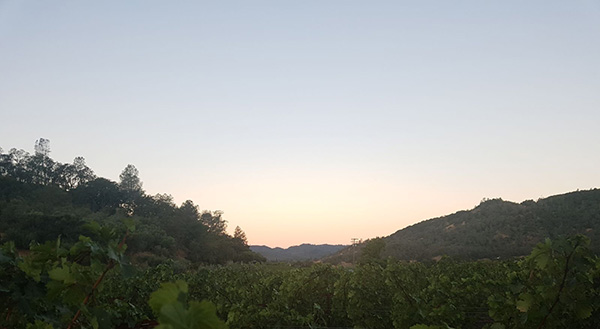
Eisele Vineyard at Sunrise
|
Joseph Phelps bought the fruit from these vineyards between 1975 and 1991, a time which saw some of the greatest bottlings of Insignia and other wines from his production, yet further cementing the quality of fruit grown here. The Araujo family first started their involvement in the Eisele Vineyard in 1991, and as such there were two bottling for this vintage, both for Phelps and under the Araujo name. Over the next two decades they led a quality-driven estate bottling of Cabernet Sauvignon, for which the brand of Araujo became as prominent as the vineyard. They also started a second wine, Altagracia, in 1999 to improve the quality of the flagship bottling. Altagracia at this time accounted for roughly 30% of production. Extensive replanting in the early 1990s means that the average vine age here is now over 25 years old. Despite the timing, most vines were planted on rootstocks other than the AXR1, so the need to pull young vineyards was unnecessary. The grapes are mostly planted from a massal selection of the best plants from the vineyard, following strict virus and disease checks, in order to enhance the unique characteristics that the vines give to the wine. The Araujo family were also pioneers in farming, converting to organic principles in 1998 and gaining Biodynamic certification with Demeter in 2002. All the plants required to make the various teas and preparations are now grown on site. The fertiliser is also made here, from a mixture of these plants, the recycled produce of the previous vintage (skins, stems, pruning wood), and the addition of manure from a local, organic, dairy farm.
The family continued to produce the wines until the 2012 vintage, when Francois Pinault led a takeover that would see the estate become part of the Artemis group in 2013. The 2012 vintage was started by the Araujo family but blended and bottled by the new team, led by general manager Antoine Donnedieu and head winemaker Helene Mingot. The portfolio of wines also includes a small bottling of Sauvignon Blanc, something which has undergone a real evolution in winemaking since the takeover. Rather than a short elevage off the lees in steel, the wines are now partly barrel fermented (15% or so in new oak), and spend time after full malolactic fermentation (either in barrel, concrete or tank) on the lees for up to 12 months. This increased contact has changed the texture, aromatic profile and potential longevity of the wines, something of which Antoine is clearly proud. As a result, the wines are released a year later than under the Araujo family. This year, all the whites were picked by the end of August. There is also a tiny production of Syrah, which has a much stronger connection to the peppery spice that you will find in the northern Rhone than to some of the overworked, over-ripe examples across many other parts of California. The two rows of Viognier that are retained here can be used to add a Cote Rotie-like lift to the aromatics of this Syrah, as long as the ripening of the two varieties is close enough to allow a co-fermentation. Altagracia now accounts for more than 50% of the Cabernet Sauvignon production, a strict selection process resulting in less, but more consistent first wines both in style and quality. Typically, most of the Cabernet Franc and Petit Verdot plantings will be used for this wine. Though the yield in 2013 was 25% higher than 2012, the total production of first wine was down 20% for the same vintages, simply by the draconian selection process now in place. There are now typically just 1700 cases of Eisele Vineyard made each year, with 2500 cases of Altagracia, 250 cases of Syrah, and 700 of the Sauvignon Blanc.
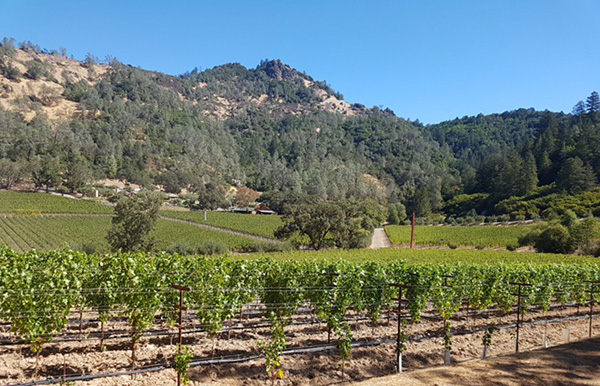
Eisele Vineyard
|
The team now has had a strong focus on finding terroir typicity in the wines, and as a result the selection has strongly been by plot on which wines go into the first and second wines. Vines planted on the alluvial fan at the core of the vineyard are most likely to make the Eisele bottling each year, while those planted slightly further from the site with more loam or clay based soils, as well as young plants, make the Altagracia. The label of the wines have also gradually changed, with Araujo no longer featuring on the label and Eisele Vineyard now prominently displayed. This reflects the change back to a more terroir-driven wine. Oak toasting has also been scaled back from heavy to a more medium blend, drawn from 3 high quality coopers. Pump-overs and general extraction techniques have been reduced, and since the takeover there has been no press wine used for either the first or second wine. Antoine has said this is not a blanket policy (Latour will typically use very carefully cut light pressings across the wines they make), but simply a case that on each year of tasting the press wines have not shown enough interesting qualities to add something to the blend. New barrels still account for close to 100% of the maturation of the wines, with slightly less but higher-toasted oak in the Altagracia. The integration and smokiness is definitely stripped back, with a more seasoned, spicy, savoury character allowed to come through. Antoine believes this helps to bring greater balance to the wines. The structure of tannins are fine and ripe in the Cabernet picked here, not needing the bold, smoky richness of a high toast barrel. The lighter levels of toast and oak tannins brought from this new regime is clearly evident between the 2012 and 2013.
Helene, the chief winemaker, actually spends more time in the vineyard than in the cellar. We first met on a two-seater ATV and spent over an hour travelling through the different plots, where she explained in great detail the importance of the various terroirs and how they often split the vineyard work in two, even between the same row of 20 or so vines, to make sure that they are getting the correct expression. Cover crops vary between legumes and cereals depending on the nutritional demands of the plant in each type of soil. Tilling and mowing change every 8 rows in one particular plot, again due to specific requirements. Irrigation is employed more as an emergency system rather than as a regular programme (with the water drawn from an on-site reservoir), and some plots are now dry-farmed. There are currently ongoing experiments with alternative, hybrid trellising systems to reduce both sun exposure and water requirements for the vines to promote both sustainability and an increase in freshness for the wines. There is also great work and research done into rootstocks for new plantings, with some interesting choices for the plots to be planted in the coming years, which will be intriguing to follow. Despite there being only 15 hectares of land, there are 7 full-time vineyard workers in addition to Helene. The day before we harvest, they are in the vineyard pre-selecting fruit that needs to be dropped from bunches where it is not be good enough to be picked, such is the rigour of approach.
A 3am alarm clock ahead of 4am picking should give a further idea of the work that goes into production. Later in the week, we are meeting at 12.30am in order to pick through the night until morning. I find the harvest barn thanks to my phone torch, where a group of cheery pickers are already getting prepared for the day ahead. Gloves, safety jacket, and a head torch are handed to me. I was only distributing and collecting the boxes today. I can quickly see why. In previous experiences across France, I have been able to keep up with a sociable pace of picking while telling all kinds of stories through rain and shine with the pickers. Here, picking is a competitive sport. The speed, accuracy and agility with which the picking is done here is spectacular to watch. It’s as much as I can do to keep up with claiming full boxes and handing out new ones. Pickers will run from row to row to keep at full pace, quick to call for a new box as they fill their current one. The full creates are stacked onto “T-bars” placed periodically in the rows, where they are collected and put onto a tractor’s trailer, which follows us through the vines. As well as being an easy way to collect the fruit, the tractor is also one of the large sources of light to guide us through the vineyard. After a few hours, the sun starts to rise, and with it the pickers raise their voices in song. By breakfast time we have picked several tonnes of fruit and are finished for the day, sustained by traditional, spicy Mexican food for breakfast.
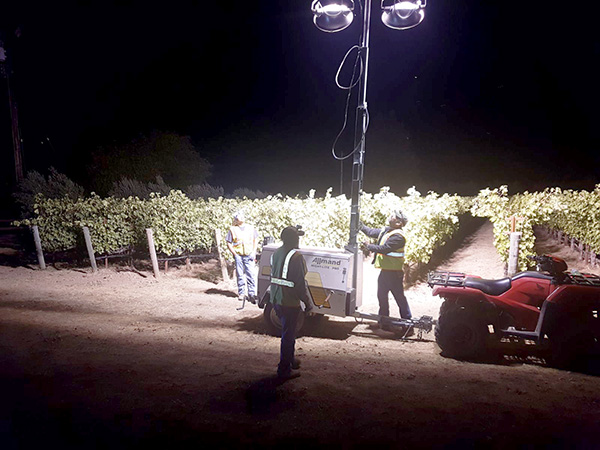
Preparing to pick at night
|
When I harvested in Burgundy and Bordeaux, there was always a sense of needing to pick quickly, daily, once the harvest was under way. This is in order to get everything in before any rain (or, more rain) once the grapes were ripe. The disease pressure of botrytis, the diluting effects of a downpour, and the fragile state of changing weather all play a part. Here, harvest can happen more gradually, only picking once everything is exactly as desired. It has been another dry year in California following much needed winter rains. There has been no rain since the spring. Days are between 26 and 34 Celsius. The only potential issue is letting a particularly hot, sunny day burn the skins on grapes, to wait until the alcohol is too high, or to over-ripen the grapes so that flavours become rich and confected. The lower yields this year are a direct result of a recent strong heatwave which shrivelled and burnt some of the grapes. This is the fruit that is dropped before the harvest. Each plot can then be given due care and picked at optimal ripeness as a result.
Following harvest, the grapes are moved the short distance to the winery and are cold stored for up to 24 hours. The following day they are turned onto a sorting table (something that did not exist before the 2013 vintage here), where a team of 10 are lined up in pairs with specific jobs - the first remove any stray leaves, and as they roll along the vibrating track raisins, green berries, insects and any other matter other than grapes is removed. The wines are then passed through a gentle basket destemmer, with the aim of causing minimal damage to the berries, before another small sorting table with four workers ensures only the best berries make it through. These grapes are then passed into steel or concrete vats, with each sub-plot of nearly 40 split by vessel to ensure each has a true expression and only makes the final blend if perceived to be of the right quality. After fermentation, the wines are blended – the best nascent wines making up Eisele – and put into barrels in the long, temperature controlled barrel tunnel, where they will stay with light rackings until bottling 18 months after harvest following a light, gentle filtration.
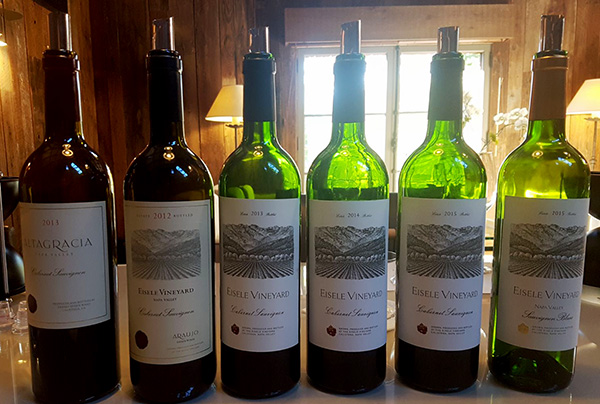
Wines to Taste
|
The resulting wines show a common thread of great florality on the nose, with very high toned fruit. The palates are round and silky, with velvet structure from fine-grained, ripe tannins. The acidity and lifted fruit brings the balance, and there has been a clear shift (and improvement, in my opinion) in the style from the lowering of toast and less extractive techniques employed. Below are the tasting notes following two vertical tastings of the wines, including the last wine harvested and barrelled by the Araujo family, but blended and bottled by the new team.
Eisele Vineyard Sauvignon Blanc 2015
An expressive, varietal-driven nose of greengage, green apple grapefruit and a touch of sweet spice from the oak. The palate shows more texture and viscosity than you might expect, a creaminess coming from the extended lees ageing and partial barrel maturation. Zippy, zesty acidity brings lift and with it notes of mandarin, passion flower and pink grapefruit. There’s a hint of struck flint to go with the light vanilla and smoky undertones, but this still shows a strong, fresh, fruit-driven core. The finish is long and again aided by the additional textural weight of lees work, adding some light curd notes to the fresh fruit.
Altagracia 2013
Very floral on the nose, cherries and blackcurrants but all in a blossom-like character. Spicy, lightly smoky oak is bringing the complexity on the nose. The palate is juicy, dense, and powerful. Cassis, black cherry and dark chocolate at the core, with powdery, ripe and refined tannins providing ample structure. Due to their ripeness, they melt quite easily into the fruit and make this wine just about approachable already, though there is clearly benefit in waiting for this wine to age further, soften, and gain complexity. The long finish is further evidence of this, but with the spicy, lightly smoky oak nicely integrated, this wine should have a long and open drinking window.
Eisele Vineyard Cabernet Sauvignon, Araujo 2012
The last vintage largely made by the Araujo family, and it does show some different characteristics through a mixture of vintage style and oak flavours. Quite opulent on the nose, there is a roasted coffee, smoke and sweet char underneath the cassis and ripe black cherry. It is integrated and balanced, but seems darker and higher octane than other wines in the line-up. The palate follows, with dense, concentrated fruit bringing dark chocolate, black cherry and cassis. The tannins are silky, smooth and well integrated, bolstered by smoky oak and notes of nutmeg and coffee. The finish is long and fine, with good lift coming from the acidity and bringing more high-toned fruit.
Eisele Vineyard Cabernet Sauvignon 2013
The first vintage fully under control of the new team brings a clear and immediate change. Initially reticent on the nose due to the backwards nature of the 2013 vintage, a little air brings notes of violet, black cherry and fresh blackcurrant. Antoine describes this as a “high definition” version of the 2012, and I can see why. The fruit shows a better level of delineation, and there is a focus and freshness added to this wine. The spicy, smoky notes are still there, but they are lighter, and less toasty than in the 2012. The palate is compact and tight at the moment, the tannins are plentiful and chewy, but ripe and fine-grained. They support a great intensity of dark fruits, tightly wound and held by the tannins and fresh acidity. The power builds towards and beyond the finish, which reveals the true potential of the wine. It is very long, fresh and well-balanced. The alcohol, acidity and fruit hold in harmony, and the tannins will allow for a very long ageing potential. One to guard in the cellar, but which should greatly reward patience. This an excellent effort and true reflection of site and vintage.
Eisele Vineyard Cabernet Sauvignon 2014
Much more red-fruited and fragrant than the 2013 at this stage, there is an open, juicy florality to the nose here that is very enticing. There is a lovely sweet spice note, but a real focus on layers of fresh fruits. The palate follows from this, with a mineral, red and balck fruit core of summer fruits. The tannins are very refined and polished, already well-integrated into the wine and giving a silky mouthfeel. You could almost drink this now, such is the moreish, silky approachability; and I would definitely start opening bottles of this before the 2013 and perhaps even the 2012. The focus and precision of the fruit brings a lifted, floral finish with just a hint of the sweet spice and toast of the oak. It feels intense but light on its feet, a refreshing and well-balanced wine that is still long. Fine, slender and harmonious.
Eisele Vineyard Cabernet Sauvignon 2015
2015 was the earliest ever harvest here. This vintage shows a commonality with the 2014 in the higher-toned floral top notes, but from here the vintage shows very differently. There is power and dark fruit here, a more brooding character that wears the spice and smoke of the oak with ease. The palate is broad and powerful. Dense, rich blackcurrant and blackberry are coated by ripe, chewy, rich tannin. This is a big, broad-shouldered wine, with smoke and spice lingering in the background behind the powerful fruit. The finish is long and still framed by the waves of ripe tannins. Fresh acidity still lifts the finish, but the focus is much more on power and black fruit than in the 2014. Worth sitting on these bottles for a few years after release to let everything knit together. This certainly shows signs of the 2013 with its focus and structure, but there is perhaps more of the ripe, rich fruit to it that adds a little exuberance. This wine was only bottled this summer, so has not fully had time to settle as yet, so it will be interesting to follow as it does so.
Eisele Vineyard Cabernet Sauvignon 2016- Barrel Sample – this will not be bottled until next summer.
Expressive and expansive on the nose, this shows superb purity of blackcurrant fruit before fleshing out into different forest and bramble tones, all supported gently by nuanced savoury spices of nutmeg, clove and pink peppercorn. The palate is more svelte than the 2015, the tannins are more refined and the fruit more tightly knit, but there is the same level of intensity. This has a higher level of precision, focus and freshness. The purity of fruit is outstanding, showing great power and length without over-ripeness or any sense of heaviness. The tannins are plentiful, but they are silky, very fine-grained, and already surprisingly well-integrated into the fruit. The finish is very long, elegant, and harmonious between fruit, acids and tannins. Evidently this is not yet the finished product, but if this continues on its current path it shows a real step forward from 2012 to this point by the team. The progression is evident in each vintage to this point, but this feels like a seminal wine in terms of realising the aims of the team here to produce an intense, long-lived wine that reflects vintage and terroir with an increased focus on freshness, fruit and harmony. Outstanding.
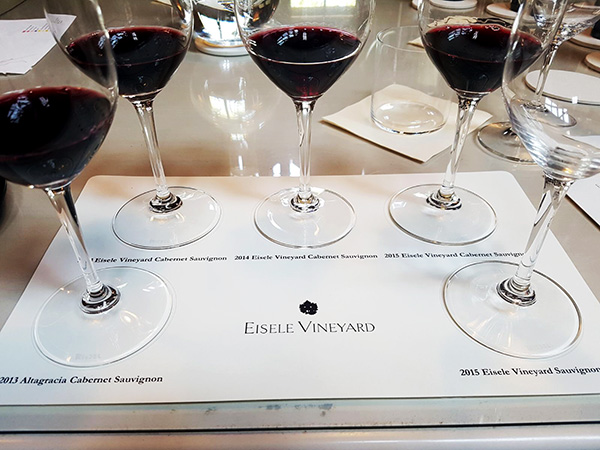
Tasting lineup
|